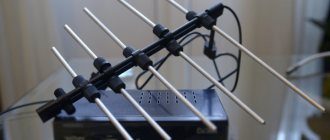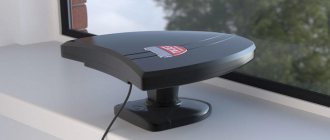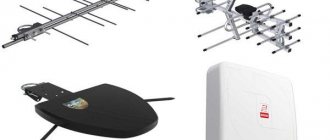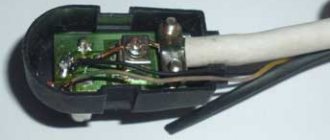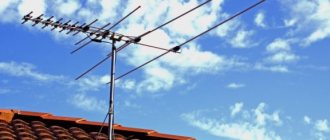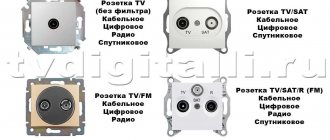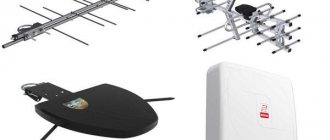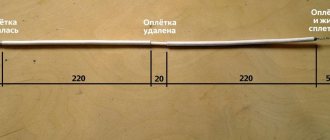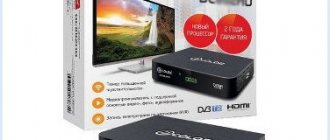Russia, like other countries, has almost completely abandoned analogue television broadcasting in favor of digital. This is a justified innovation, since digital can significantly improve the quality of broadcasting. However, not all TVs are suitable for setting up a new type of broadcast. How can you determine if your TV is suitable or if you need to buy a special receiver? Let's figure it out now.
How to determine if your TV has a digital tuner
Studying the technical characteristics is one of the key criteria for choosing a new TV. The specifications reflect all the necessary information about the functionality of the equipment, including support for digital channels. In Russia the DVB-T2 standard is used. Therefore, it is necessary to purchase a TV model that is equipped with an appropriate decoder.
How can I find out if my TV supports digital television if I can’t see the technical specifications? A visual inspection of the equipment can also answer this question. Take a look at the communication panel. If there is a connector marked “Digital input”, which translates from English as “digital input”, then the TV receives digital broadcasting.
TVs manufactured before 1998 absolutely do not support the DVB-T2 standard. The equipment released at this time was focused on analogue broadcasting. There are very few exceptions to this rule.
Until 2004, TVs with a built-in digital decoder were produced, but these were mainly expensive devices with a screen diagonal of 42 inches and above. Projection TVs with DVB-T2 support are extremely rare.
If the TV was released after 2004, then the likelihood of supporting digital broadcasting increases significantly. The main ways to determine the TV broadcast format:
- Please read the technical documentation carefully. If the “DVB-T2” column is marked “yes,” the TV is suitable for the “digital” setting.
- The corresponding markings can also be found on the factory box of the TV. If there is an inscription “DVB-T”, then you will still have to buy a set-top box, since this format is outdated.
- Find your TV model on the official website of a popular online store, for example, Yandex Market. Study the technical specifications.
Some manufacturers encrypt information about the built-in digital tuner in the name of the TV. Mostly support for the DVB-T2 standard is indicated by the letter “H”. However, the symbol may vary depending on the model and manufacturer.
If you cannot find the information you need, contact the manufacturer's customer service. Call center managers will provide all the necessary information. Now you know how to determine whether your TV is equipped with a digital decoder.
Checking DVB-T2 support manually
If your model is not on the list above, don’t despair. Let's determine whether digital signal support is available manually. There are 3 simple ways.
We look at the model markings
To do this, you will need to study the model name. It is indicated on the case or in the operating instructions (section “Digital standard support”). Depending on the manufacturer, some characters will clearly indicate support for "digits".
Samsung
The fact that the panel has a DVB-T2 tuner is indicated by the presence of one or two letters, which are located in the middle of the full name to the last three. DK, ST, SB, T (AT), K (AK), U, AU, B, AB indicate the presence of a receiver.
LG
Owners of TVs that came off the assembly line before 2021 should pay attention to the last letter: V or T means the presence of a TV tuner. In models released after 2021, the presence of a receiver is indicated by the second letter from the end. For the countries of the former CIS, only models with the index L are suitable.
Sony and Panasonic
It is impossible to tell by the name of a TV whether it is equipped with a DVB-T2 decoder. Therefore, shortly before purchasing products from Sony, you should carefully read the technical documentation, where the manufacturer indicates the option of receiving a signal “digitally” without having to purchase a separate set-top box.
Sharp
The letter H, located in the middle of the Sharp model name, indicates the presence of an MPEG4 tuner that receives digital TV channels.
Other models
Wide-format panels from Hyundai, containing TS or T2 in the name, are equipped with built-in decoders. Televisions from BBK have an identical designation. In JVC equipment, the presence of a decoder is indicated by the combination of letters LT in the model name. Mystery LCD panels marked LT2 are equipped with DVB-T2 modules. Most TVs from Thomson and Dexp, released later than 2014, are equipped with DVB-T2 tuners, but before purchasing it is worth entering exact data about the model into the search window of the online service.
We check through Yandex.Market
To find out if the model has a DVB-T2 tuner, you can use the Yandex.Market service.
- The exact name and markings are entered into the search field.
- On the search results page you will see the model you are looking for. Click on the “Characteristics” tab.
- In the item called “Signal reception”, the option to support DVB-T2 is noted.
Call the manufacturer's technical support
If you could not find the required information in Yandex.Market, and the operating instructions were irretrievably lost, contact a service center that services branded equipment.
On which TVs can you watch digital TV?
The ability to configure digital broadcasting is determined by the presence of a special tuner, which was discussed earlier. DVB-T2 modules can be:
- built-in – hardware components located inside the TV;
- external - an independent device that connects to the TV.
On TVs with a built-in tuner, you can watch digital TV immediately after connecting the antenna cable to the appropriate connector and tuning the channels. If the TV is old and is not equipped with this component, then you will have to buy a special set-top box.
Manufacturers leave all the necessary markers on the factory boxes, as well as in the technical documentation. For example, the abbreviation DVB-T2 indicates support for digital broadcasting. The S2 marking indicates that the TV can also be used to set up satellite TV.
Practice shows that problems arise in situations where it is not possible to familiarize yourself with the technical documentation. However, current ways to solve this problem have already been discussed. Mostly, all TVs released after 2005 support digital TV, but not all models are suitable for the DVB-T2 standard.
The TV does not support DVB-T2: what to do
If the TV only supports analogue broadcasting, there are 2 options:
Option 1 is to buy a digital set-top box of the DVB-T2 standard.
DVB-T2 tuners belong to the second generation of the DVB-T format. Unlike their predecessors, they have increased throughput and an updated architecture that ensures stable reception. Depending on the brand and retail price, tuners may have the following features:
- recording broadcasts on a built-in disk or removable flash drive;
- connecting a USB flash drive or hard drive;
- Internet connection via built-in adapter.
Set-top boxes running Andro>HDMI or composite cable, which is inserted into the appropriate socket.
How to check if your TV is receiving a digital signal
Let's assume that we are not talking about a potential purchase, but about a TV purchased long ago. It is necessary to rely on information from trusted sources. Therefore, the best way to determine whether a TV supports a digital signal is to familiarize yourself with the characteristics of the model on the manufacturer’s website.
As an example, consider equipment from the South Korean brand Samsung. The company reports that absolutely all TVs released no later than 5 years ago support the DVB-T2 standard. Open the company's official website, and then enter the model name in the search box. Please refer to the specifications for details on the availability of built-in modules. Information is provided in the “Signal Reception” section.
Checking the signal quality
Users have always checked the quality of the analog signal by eye. The appearance of minor interference indicated the need to change the antenna position. With digital broadcasting, everything is completely different, largely due to the use of special compression codecs. Poor reception quality will result in constant freezing of the image, and it is possible that the broadcast will be interrupted altogether.
Open the main TV menu, and then go to settings. Go to the “Signal Quality” section. It is possible that the name of this item may vary slightly depending on the model of equipment. This section can also be activated by triple-clicking the “Info” button. Signal quality is displayed as a percentage. If the indicator is above 60%, then there will be no problems with the broadcast.
It is much easier if you use an indoor antenna, since it can easily be turned towards the repeater in cases where the position of the device has been accidentally changed. Achieving 100% signal quality is almost impossible. Mostly this indicator is achieved only in the line of sight of the television tower.
How to install an antenna for digital TV
A properly installed antenna is the key to high quality signal reception. Make sure it is facing towards the repeater. Users will be able to carry out diagnostics using interactive maps. For high-quality digital signal reception by your TV, you need to place the antenna on the windowsill and then point it towards the TV tower.
In apartments and houses with plastic windows, you need to fix the antenna above the window profile.
The specifics of installing an outdoor antenna are significantly different. This is a more diverse and multifaceted process. Before you finally fix the device, you need to check it. Connect the antenna to the TV, and then evaluate the reception quality. If interference is present, you need to change the position of the TV antenna.
During the testing process, pay attention not only to the signal quality, but also to the number of channels found. Terrestrial TV includes over 20 free channels. Signal quality above 50% is a satisfactory result. It is extremely important that the reception is stable, that is, the values should have a minimum amplitude of fluctuations. If your TV does not support digital signal, you will have to buy a set-top box.
Signal instability and constant broadcast interruptions indicate incorrect antenna placement. In settlements remote from television towers, antennas with an amplifier are used. This device will require a separate power source. It is advisable to install outdoor antennas at a high point, such as on the roof. Keep in mind that trees and buildings are barriers that reduce signal quality.
When an antenna is not needed
Reception quality is a priority indicator when setting up digital and satellite broadcasting. Not in all cases it is necessary to buy an antenna. In many ways, the relevance of using this device depends on the distance to the repeater. For example, in areas with good reception, you can use regular indoor antennas without an amplifier.
In remote areas from TV towers, you need to use amplifiers and external UHF antennas. If the signal quality is still unsatisfactory, you need to raise the device to the mast. You still won't be able to do without an antenna, even on a TV with a digital receiver.
What is dvb t 2
When a person goes to a hardware store to buy a TV, the question of the quality of the transmitted image and the characteristics of the unit often arise. In addition, today the price of liquid crystal models is rather high. Therefore, I want to choose a high-quality, multifunctional option at an affordable cost.
However, it is not enough to pay attention to the broadcast function of digital terrestrial TV. Therefore, often when you want to buy a new tuner and enjoy DTV, nuances arise when selecting a model and installing it.
Before you go buy a tuner, you should understand what it is and how to install it. A digital tuner is a decoder that connects to a TV to transmit images. The device helps to receive high-quality signals directly on TV.
Most new TV models have a built-in T2 digital receiver. There are also options with two types of tuner at once - T2 and S2. To find out what type of receiver is built into your equipment, you need to study the characteristics of the model in detail. They are written on the box or in the instruction manual. If the model has a built-in decoder, then you can purchase a suitable tuner for watching TV.
ATTENTION! External tuners are very popular today. Buying an expensive TV is not always possible. But purchasing a device at a more affordable price for connecting T2 will be much easier. Today, T2 format set-top boxes are popular; they can be used to easily connect digital terrestrial channels. A DVB-S2 set-top box will be needed if a satellite dish is installed, but there is no TV with a decoder.
The tuner can transmit several signals at once. The most popular options include:
- DVB-T. Receives and transmits high-precision signals. To connect it, you only need an antenna.
- DVB-T2. An improved version of DVB-T, its main difference is good channel transmission with high characteristics. Today this is the most common version of digital television.
- DVB-C. Picks up digital cable TV. To use, you need a special provider card.
- DVB-S. With this tuner you can easily connect your antenna directly to your TV.
- DVB-S2. This is the second generation of DVB-S, which only works with a special decoder. Can be used with different modulations.
IMPORTANT! Which type of tuner is right for you will depend on what kind of TV you want to watch.
How to tune TV channels
Connecting your TV to an antenna is only half the job. Problems with connecting devices do not arise at all if the TV supports digital format. An important part of connecting digitally is setting up channels. Absolutely every TV is different, so the setup process will vary depending on the software. Of course, the interface also changes depending on the firmware. All this indicates that there is no single instruction for setting up TV channels.
However, users will not need universal instructions. Study the technical documentation, which describes the process of searching and setting up channels step by step.
When you turn on a TV or digital set-top box for the first time, the equipment offers to automatically tune in channels. There is an alternative way - manual search.
Auto channel search
You need to go to the settings, and then launch “Autosearch”. Wait a few minutes while the TV picks up digital channels. The device automatically searches through the available frequencies, on which, in fact, free channels are broadcast. Users must first uncheck the box next to “Analogue TV”. However, on some TVs there is no such item at all.
Some regional channels are still broadcast on analogue frequencies. This aspect also needs to be taken into account.
Quite often there are cases when automatic search gives absolutely no results. However, there is a completely logical explanation for this. It should be noted that analog and digital television are extremely different standards. On digital TV it is possible to broadcast a whole range of channels on one frequency. Therefore, it is possible that approximately 30% of the search time the channels will not be found, but already by 40% the situation will change noticeably.
To date, two multiplexes have been launched in Russia. It is possible that the third will be launched next year. Each multiplex has about 10 channels. The list of available TV channels can be significantly expanded by using the services of a digital TV provider. However, access to them will be provided only after paying a subscription fee. Immediately after the automatic search is completed, be sure to save the found channels. Some TV models do this automatically. In the settings you can also change the order of TV channels.
Tuning and searching for channels manually
In some situations, the automatic search option does not work, so you have to search for channels manually. To manually search, you will need the frequencies of multiplexes in your region. Finding the necessary information should not be difficult. Open the website rtrs.ru, and then go to the “Coverage Map” section. This contains all the necessary information.
Follow simple instructions:
- Select your locality on the map of the Russian Federation.
- Click on the TV tower icon.
- If there is no repeater in your locality, click on the nearest one.
- A dialog box will open with all multiplex frequencies.
- Enter numbers into the appropriate windows while searching for channels.
Of course, manual search will take much more free time.
List of popular models with built-in receiver:
- Samsung (Samsung);
- Sony (Sony);
- Toshiba (Toshiba);
- Panasonic (Panasonic);
- LG (ElG);
- Thomson (Thomson);
- Dexp (Dexp);
- BBK (BBK).
The best option is a TV that meets Smart TV standards. Such models support viewing IPTV programs via an Internet connection. To use the option, you need to download and install a special application.
If you plan to connect cable TV, choose a TV with a CI+ slot and a DVB-C2 tuner. The local operator cable is connected through an external connector (slot), and the tuner decodes the incoming information.

